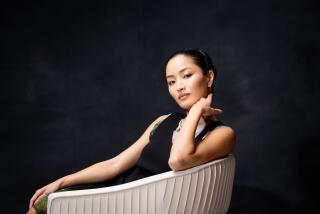KANYA SANJO V STAGES KABUKI DANCE DRAMA
- Share via
Although the dazzling Kabuki theater of Japan has been a male enclave since 1629, women often specialize in related dance forms and head important Kabuki dance schools. In this regard, grandmaster Kanya Sanjo V brought pupils and guests to the stage of the Japan America Theatre on Sunday for her 30th annual Kabuki program.
After an introduction ceremony, distribution of gifts to the audience and three decidedly tepid floral/festival dances, the American premiere of the Kabuki dance drama “Suma no Utsushie” provided capable performances by Kanya Sanjo V, Kangiku Sanjo, Kan-oh Sanjo and guest Tazo Fujima (the only male on the program).
Based on a celebrated Noh play about longing sustained beyond the grave, “Suma no Utsushie” depicted the desolation of two sisters--both fisher girls--when the prince they each love deserts them, and when the elder is threatened by a crude, lecherous fisherman.
Major moments in this narrative invariably expanded into formal dance statements, with the lyric or dramatic intention expressed more through stylized gesture and shifts of body position than footwork.
Since the sisters’ names--Matsukaze (wind in the pines) and Murasame (autumn rain)--refer to elements in nature, their personal differences assumed rich symbolic implications. A deep, atmospheric work, presented simply (to canned music), but securely enough to make lucid both its style and content.
More to Read
The biggest entertainment stories
Get our big stories about Hollywood, film, television, music, arts, culture and more right in your inbox as soon as they publish.
You may occasionally receive promotional content from the Los Angeles Times.










